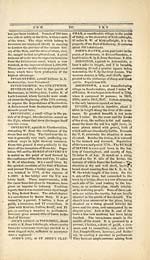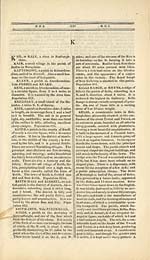Gazetteer of Scotland
(150) Page 148 - IRV
Download files
Complete book:
Individual page:
Thumbnail gallery: Grid view | List view

j u a
the customs, and from a large tract of land
which rents at L.500 per annum. The har-
bour is commodious, with 10 or 12 feet wa-
ter on the bar at spring tides. A number
of brigs are employed in the coal trade.
The imports are iron, hemp, flax, wood, and
grain. Population 4500.
IRVINE, a river in Ayrshire, which takes
its rise in the E. side of Loudonhill, in the \
parish of Loudon, and falls into the Frith
of Clyde, at the town of Irvine. This river
forms the boundary betwixt the bailiwicks
of Cunningham and Kyle.
ISAY, a smallisland of the Hebrides, in
West Loch Tarbert.
ISHOL, a smallisland of Argyleshire, in
Loch Linnhe.
ISHOL, an island on the south-west coast
of Hay.
ISLA, or ILA, a river in Forfarshire,
which rises in the Grampian mountains,
several miles northward of Mount Blair.
Washing the foot of that hill, it turns east-
ward, traverses the long narrow vale of
Glenisla, below which it forms a cascade,
70 or SO feet perpendicular, called the
Reeky Linn. After passing the linn, it
forms a deep pool of water, called Corral.
It then divides into two branches, which,
uniting again, form a pleasant island, called
the Stanner Island. It afterwards proceeds
westward through the valley of Strathmore,
receiving the Dean at Glammis castle,
Mclgam at Airly castle, and Ericht near
Cupar. By these rivers its size is consider-
ably increased, and, now flowing with a
smooth and gentle course, it falls into the
Tay at Kinclaven. In rainy seasons it
proves very prejudicial to theadjacent fields,
and sometimes sweeps away whole harvests.
Near its junction with the Tay, it possesses
several valuable salmon-fishings.
ISLA, the name of a river in Banffshire,
which takes its rise on the borders of In-
verness-shire, and empties itself into the
Deveron, after a short and rapid course of
about 12 miles.
ISLE MARTIN, a fishing station in Loch
Broom, on the W. coast of Ross-shire, with
a custom-house. It lies 5 miles N. of Ul-
lapool.
ISLE TANERA, a fishing station and
village in Ross-shire, 3 miles N. of Isle of
Martin.
ISLE of WHITHORN, a good harbour
and village in Wigtonshire, near the royal
burgh of Whithorn. P. 390.
JURA, one of the Hebrides, lying oppo-
site to the district of Knapdale. It extends
UG miles in length, and is on an average
US J U R
seven broad. It is the most rugged of the
Western Isles, being composed chiefly of
huge rocks, irregularly piled on one ano-
ther. The chief of these mountains extends
in the form of a ridge from S. to N. nearly
in the middle of the island. They are four
in number, which are termed the Paps of
Jura, and are conspicuous at a great dis-
tance. The southern one is named Beimi •
achaolis; the next and highest, Beinn-an-
oir; the third, Beinn-sheunta; and that to
the north, Corra-bhein. Beinn-an-oir is
composed of large stones, covered with
mosses near the base ; but all above is bare
and unconnected. From the W. side of
the hill runs a narrow stripe of rock into
the sea, called the slide of the old hag.
Jura itself displays a stupendous front of
rock, varied with innumerable little lakes,
of the most romantic appearance, and cal-
culated to raise grand and sublime emo-
tions in the mind of the spectator. To the
S. the island of Hay lies almost under his
feet, and beyond that the N. of Ireland ; to
the E. Gigha, Kintyre, Arran, and the Frith
of Clyde, bounded by Ayrshire, and an
amazingtrack of mountains as far as Ben-
lomond. Over the Western Ocean are seen
Colonsay, Oransay, Mull, Iona, Staffa, and
the neighbouring isles ; and, still further,
the long extended islands of Coll and Tyrie.
Beinn-an-bir is elevated 2420 feet above
the level of the sea. All the inhabitants
live on the E. side. The only crops are
oats, barley, potatoes and flax; the chief
manure is the sea-weedwhich is cast ashore.
There are two fine harbours on the E. coast
of the island; there are also some anchor-
ing places on the W. coast. At the N. end
of Jura are situated three inhabited islands,
viz Scarba, Lunga, and 3alnahuaigh. Be-
tween Scarba and Jura is that famous gulph
called Coryvreckan. There is only one
small village, called Jura, on the E. coast
of the island. There is a great abundance
of iron ore, and a vein of the black oxide
of manganese. On the shores of tbeW.
coast there are found great quantities of a
fine kind of sand, which is carried away for
the manufacture of glass. TheGnelicisthe
only language spoken in the island. Popu-
lation 1157.
JURA and COLONSAY, a parish of Ar-
gyleshire, composed of nine islands, of
which Jura is the largest. The islands of
Colonsay and Oransay, of Scarba, Lunga,
Balnahuaigh, with three small uninhabi-
ted isles on the N. of Jura, form the rest
of the district. Population 1913.
the customs, and from a large tract of land
which rents at L.500 per annum. The har-
bour is commodious, with 10 or 12 feet wa-
ter on the bar at spring tides. A number
of brigs are employed in the coal trade.
The imports are iron, hemp, flax, wood, and
grain. Population 4500.
IRVINE, a river in Ayrshire, which takes
its rise in the E. side of Loudonhill, in the \
parish of Loudon, and falls into the Frith
of Clyde, at the town of Irvine. This river
forms the boundary betwixt the bailiwicks
of Cunningham and Kyle.
ISAY, a smallisland of the Hebrides, in
West Loch Tarbert.
ISHOL, a smallisland of Argyleshire, in
Loch Linnhe.
ISHOL, an island on the south-west coast
of Hay.
ISLA, or ILA, a river in Forfarshire,
which rises in the Grampian mountains,
several miles northward of Mount Blair.
Washing the foot of that hill, it turns east-
ward, traverses the long narrow vale of
Glenisla, below which it forms a cascade,
70 or SO feet perpendicular, called the
Reeky Linn. After passing the linn, it
forms a deep pool of water, called Corral.
It then divides into two branches, which,
uniting again, form a pleasant island, called
the Stanner Island. It afterwards proceeds
westward through the valley of Strathmore,
receiving the Dean at Glammis castle,
Mclgam at Airly castle, and Ericht near
Cupar. By these rivers its size is consider-
ably increased, and, now flowing with a
smooth and gentle course, it falls into the
Tay at Kinclaven. In rainy seasons it
proves very prejudicial to theadjacent fields,
and sometimes sweeps away whole harvests.
Near its junction with the Tay, it possesses
several valuable salmon-fishings.
ISLA, the name of a river in Banffshire,
which takes its rise on the borders of In-
verness-shire, and empties itself into the
Deveron, after a short and rapid course of
about 12 miles.
ISLE MARTIN, a fishing station in Loch
Broom, on the W. coast of Ross-shire, with
a custom-house. It lies 5 miles N. of Ul-
lapool.
ISLE TANERA, a fishing station and
village in Ross-shire, 3 miles N. of Isle of
Martin.
ISLE of WHITHORN, a good harbour
and village in Wigtonshire, near the royal
burgh of Whithorn. P. 390.
JURA, one of the Hebrides, lying oppo-
site to the district of Knapdale. It extends
UG miles in length, and is on an average
US J U R
seven broad. It is the most rugged of the
Western Isles, being composed chiefly of
huge rocks, irregularly piled on one ano-
ther. The chief of these mountains extends
in the form of a ridge from S. to N. nearly
in the middle of the island. They are four
in number, which are termed the Paps of
Jura, and are conspicuous at a great dis-
tance. The southern one is named Beimi •
achaolis; the next and highest, Beinn-an-
oir; the third, Beinn-sheunta; and that to
the north, Corra-bhein. Beinn-an-oir is
composed of large stones, covered with
mosses near the base ; but all above is bare
and unconnected. From the W. side of
the hill runs a narrow stripe of rock into
the sea, called the slide of the old hag.
Jura itself displays a stupendous front of
rock, varied with innumerable little lakes,
of the most romantic appearance, and cal-
culated to raise grand and sublime emo-
tions in the mind of the spectator. To the
S. the island of Hay lies almost under his
feet, and beyond that the N. of Ireland ; to
the E. Gigha, Kintyre, Arran, and the Frith
of Clyde, bounded by Ayrshire, and an
amazingtrack of mountains as far as Ben-
lomond. Over the Western Ocean are seen
Colonsay, Oransay, Mull, Iona, Staffa, and
the neighbouring isles ; and, still further,
the long extended islands of Coll and Tyrie.
Beinn-an-bir is elevated 2420 feet above
the level of the sea. All the inhabitants
live on the E. side. The only crops are
oats, barley, potatoes and flax; the chief
manure is the sea-weedwhich is cast ashore.
There are two fine harbours on the E. coast
of the island; there are also some anchor-
ing places on the W. coast. At the N. end
of Jura are situated three inhabited islands,
viz Scarba, Lunga, and 3alnahuaigh. Be-
tween Scarba and Jura is that famous gulph
called Coryvreckan. There is only one
small village, called Jura, on the E. coast
of the island. There is a great abundance
of iron ore, and a vein of the black oxide
of manganese. On the shores of tbeW.
coast there are found great quantities of a
fine kind of sand, which is carried away for
the manufacture of glass. TheGnelicisthe
only language spoken in the island. Popu-
lation 1157.
JURA and COLONSAY, a parish of Ar-
gyleshire, composed of nine islands, of
which Jura is the largest. The islands of
Colonsay and Oransay, of Scarba, Lunga,
Balnahuaigh, with three small uninhabi-
ted isles on the N. of Jura, form the rest
of the district. Population 1913.
Set display mode to: Large image | Transcription
Images and transcriptions on this page, including medium image downloads, may be used under the Creative Commons Attribution 4.0 International Licence unless otherwise stated. ![]()
| Gazetteers of Scotland, 1803-1901 > Gazetteer of Scotland > (150) Page 148 - IRV |
|---|
| Permanent URL | https://digital.nls.uk/97423494 |
|---|

